|

by Dan
Davidson
from his book
Shape Power, 1997 (Parts of Chapter 6)
Joe Parr Pyramid Energy Bubble Discovery
The material on Joe Parr was given during my talk at the
International Tesla Society in 1992. The following text and graphs
are from that speech. Some of the information on gravity wheel
experiments was given at the 1996 Natural Philosophy Alliance
sub-group, during the American Association for the Advancement of
Science (AAAS) conference in Flagstaff Arizona at the Northern
Arizona University campus.
Shape as an Energy Sensor
A major breakthrough has been achieved by
Joe Parr, whereby he has developed several sensors that quantify
pyramid energy. His gamma ray transducer is based on his discovery
that pyramid energy attenuates gamma rays. He has discovered that
one of the aspects of aether energy in and around a pyramid is as a
spherical aetheric energy field centered at the 1/3 height level.
This is shown in Figure 7.2.1-1 which depicts one of Joe’s first
experimental setups to detect pyramid energy fields. This discovery
has led to the possibility of a free energy machine as well as a
true space drive based on generation of gravitational force fields
using rotated pyramid shapes.
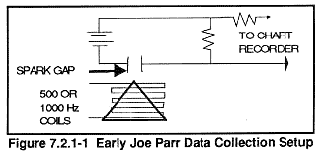
One of the things which Joe Parr found in the pyramid energy
conversion experiments, as depicted in Figure 7.2.1-1, was that the
pyramids quit responding now and then and he had no explanation as
to why. He did find correlation with celestial events with his
experiments. Sun spot activity seems to affect the intensity of the
pyramid energy bubble.
The gravity energy sensor, which Joe Parr discovered, involves the
Great Pyramid and pyramid shapes in general. This sensor uses a
static (i.e., non-moving) pyramid aligned north-south/east-west.
Flat coils wound on audio tape reels were placed on the north and
south side of the pyramid. A spark gap, made from a blown 1
microfarad capacitor, was placed at the apex of the pyramid in
series with a battery, resistor and chart recorder. A chart recorder
registered daily changes in the energies around the pyramid.
The chart recorder records the state of a bubble of energy which
surrounded the pyramid. The energy bubble, over time, had various
levels of opacity to all types of radiation. Experiments putting
radio frequency emitters, radioactive sources - specifically beta
and gamma emitters, magnetic sources, and ion sources all showed
attenuation when in the energy bubble which surrounds the pyramid.
Intensive research over 13 years showed that the bubble could be fed
negative ions and this would intensify the opacity of the bubble. At
certain times of the year the energy bubble would totally block the
force of gravity, nuclear radiation, and electromagnetic radiation.
Another effect revealed that the pyramid seemed to be resonant at
500 and 1000 Hz. This means that the force field around the pyramid
become totally opaque (i.e., non-conductive) to all known forces.
Dynamic Pyramid ES Generation
At one time during the 11 year sun
spot cycle, the static pyramid sensor went dead and quit providing
data. In order to find another method of continuing the research,
the reasoning was that a moving sensor could possibly continue
providing data. Joe Parr built an elaborate experimental setup he
named the “centrifuge”. The centrifuge “pyramid motor” is
illustrated in figure 7.2.2-1.
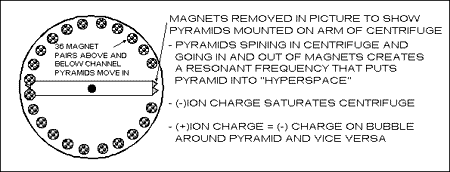
Figure 7.2.2-1 John
Parr's Pyramid Centrifuge
Extensive experiments with the centrifuge provided additional data
on the pyramid energy bubble. Positive ions in the centrifuge would
cause the pyramid to be drawn to the moon. Negative ions in the
centrifuge would cause the pyramid to be repelled away from the
moon. At certain times of the year (around December 8th-15th and May
8th-15th) the energy bubble around the pyramids in the centrifuge
would become totally opaque to all local gravitation,
electromagnetic, and inertial forces. When this happened, the little
one inch base pyramids would rip off the end of the centrifuge arm
causing extensive damage to the interior of the centrifuge.
Detailed
analysis of the amount of energy of the pyramid, needed to rip it
free of its epoxy mounting, showed that an 8 gram pyramid had
approximately 2000 pounds of force (i.e., 113,000 times increase in
kinetic energy). It is hypothesized that the pyramid moves into a
different time/space condition, which Joe called hyperspace, when
the pyramid is in the alternating magnetic field. When the pyramid
moves out of the alternating magnetic field of the centrifuge, the
pyramid comes out of h-space with huge amounts of additional energy.
The centrifuge experiments also operated the same as the static
pyramid in that putting radio frequency sources, radioactive
sources, magnetic sources, and ion sources inside the pyramid showed
that the energy of the energy sources was attenuated when in the
pyramid energy bubble.
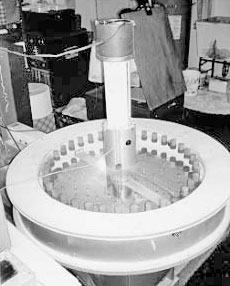
Figure 7.2.2-2
Photograph of Joe Parr’s Pyramid Centrifuge
This method relies on pyramids mounted on the outside of a rotor
which is rapidly rotated. An E-field perpendicular to the rotor is
aligned with rotor axis. A magnetic field is aligned perpendicular
to the axis of the rotor. Thus, when the rotor spins, the pyramids
not only make and break the E-field but have an alternating magnetic
field at right angles to the E-field.
Analysis revealed detail in regard to alignment of the magnetic
field with the pyramids. If the magnets cover the entire width of
the rotor, then the electrostatic field gets generated in one
direction on one side of the rotor axis and in the opposite
direction on the other side of the axis. The question is - would
this nullify the energy generation effect or does it make any
difference since electrons are electrons???
Joe Parr Gravity Wheel Experiments
The centrifuge research led Joe Parr to hypothesize that perhaps a
three dimensional pyramid was not totally necessary. A new
experiment was devised which replaced the large centrifuge assembly
with a small specially designed wheel mounted on a shaft and spun by
a small high speed motor.
Joe Parr developed a simpler dynamic experiment related to the
centrifuge but a much simpler apparatus to perform experiments. This
experimental setup is shown in Figure 7.2.3-1. It is a four inch
wheel made of printed circuit board material with 24 triangles the
shape of the great pyramid face around the circumference of the
wheel. The triangles are placed opposite each other on both sides of
the wheel. The wheel, I have termed the gravity wheel, spins in
between two stators which have low gauss (100 gauss each) ceramic
magnets which are positioned so the magnet is cross the 1/3rd height
of the triangles. An electrostatic ion generator is positioned next
to the experiment to feed ions to the experiment. Gravitation
bubbles or forcefields form around each of the triangles when the
wheel is spun at high speeds. The ion generator is not shown in
figure 7.2.3-1. Photograph of Joe’s gravity wheel experiment is
shown in figure 7.2.3-3.
Force Fields Of The Gravity Wheel Experiment
The Parr experiments revealed the force fields created by the
spinning gravity wheel experiment and are depicted in Figure
7.2.4-1. There are two types of force fields built up in and around
the experiment. There is an ovoid shaped forcefield around each of
the copper triangles. When these small force fields build up in
intensity, they cause a drag on the motor which can be plainly heard
in the lab. There is a larger forcefield which builds up around the
entire experiment setup. Tests done by Joe Parr using special
instrumentation and a dowser plus independent tests by the author
with a clairvoyant and a clairsentient, all verify the large force
field around the experimental setup plus the smaller forcefields
around each of the triangles.
What Joe has discovered is that the earth moves through energy
conduits which go from our sun to other planets and star systems.
When the gravity wheel experiment crosses one of these energy
conduits, the forcefield around the copper triangles intensifies to
the extent that the bubble goes opaque to all local forces and
starts moving down the conduit very rapidly and a scale upset
occurs. Attempts at simulating the energy conduit thus far have
failed. We are in the process of evaluating the data and we have
found some correlation with planetary and stellar conjunctions where
the earth is lined up with other planets or stars and our sun. The
data analysis is currently in its infancy so we can make no
statements of solid fact other than that we are getting some very
impressive gravitational effects.
Duplication of Gravity Wheel Experiments
The author had been following Joe Parr’s experiments over several
years; and after Joe had some initial success with the new
experimental setup, the author, with Joe Parr’s assistance, built a
duplicate experiment.
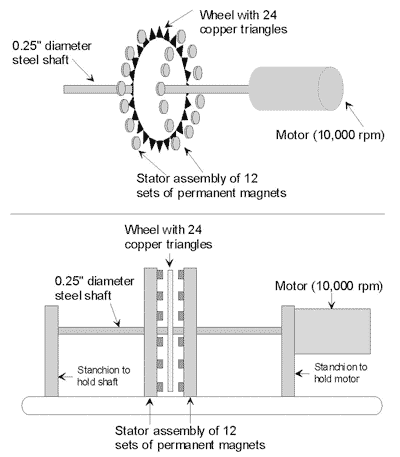
Figure 7.2.3-1
Rotor Using Triangles As Shape Power Collectors
Gravity Wheel Experimental Setup and Results
It took several months to get my version of the experiment to
operate successfully. Tuning involved getting the experimental setup
oriented properly and proper grounding. The shaft must be oriented
east-west. A negative ion source is set within a few feet of the
spinning wheel to feed the force fields which form around the copper
triangles affixed to the gravity wheel. The experiment is set on a
delicate scale which measures accurate to 0.5 grams. The static
weight of my experimental setup is about 1200 grams. Joe Parr’s
version is about 1800 grams. My experiment used machined maplewood
to hold the motor and shaft, and the stanchions which hold the
magnets and Parr’s experiment was made of machined aluminum. A
photograph of my gravity wheel experiment is shown in figure
7.3.1-1.

Figure 7.2.3-3
Close-up of Joe’s Gravity Wheel Experiment.
The main result between my version of the gravity wheel experiment
and Joe’s is that Joe’s burns out a motor at nearly every conduit
and mine doesn’t. Evidently, the interaction of the force field with
the aluminum stanchions in Joe’s version cause enough resistance to
burn out the motor.
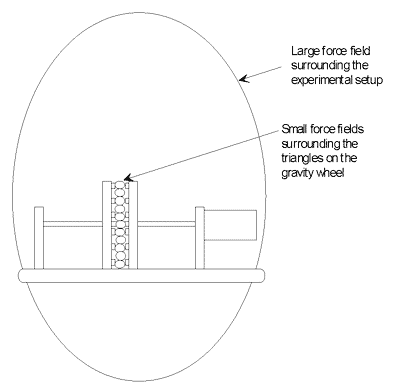
Figure 7.2.3-1.
Ovoid Forcefield Around Gravity Wheel Experiment
and
Small Energy Bubbles Surrounding each of the Triangles of the
Gravity Wheel
During experimental operations, the weight of the experiment can
drop from 0 to -6.5 grams. When one considers that the gravity wheel
with the copper triangles weighs about 12 grams, the total normal
operational levitation effect is on the order of 50% weight loss.
This by itself is a remarkable experimental effect and deserves
acute attention.
The scale which is used in the experiment is an Ohaus Precision Plus
purchased from Cole Parmer. The scale can measure accurately within
0.5 grams over a range of 0-4000 grams. The scale has an RS¬232
serial interface which allows the scale to be interfaced to a
printer or computer. The scale outputs the weight continuously
except when there is a scale upset. The upset weight can be varied
and it was set at the maximum of 5 grams. This means that if the
weight on the scale changes more than 5 grams within a couple of
milliseconds, then the RS-232 interface stops outputting the RS-232
signal contained the weight as measured by the scale.
My preliminary hookup of the scale was to a computer; however, the
intense forcefield which builds up around the experiment destroyed
two computer interface cards. Since the RS-232 interface stops
outputting data on a scale upset, the serial output of the scale was
converted to a voltage level and used as an indicator. When the
voltage drops, a scale upset has occurred. The voltage level change
was/is interfaced into a pulse counter. This provides a count of
scale upsets greater than 5 grams. Figure 7.3.1-3 is a graph over
time of scale upsets. This shows the count of when the gravity wheel
changed weight over 5 grams. If the 6.5 gram weight loss is added to
the 5 gram upset, we are looking at nearly a 100% weight loss of the
gravity wheel. Joe Parr’s gravity wheel experiment and my both got
the same interstellar conduit on April 11, 1996.
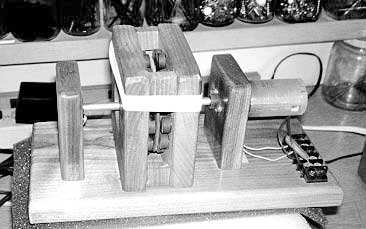
Figure 7.3.1-1
Close-up of Dan’s Gravity Wheel Experiment
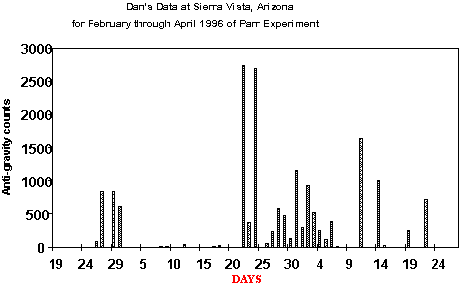
Figure 7.3.1-3. Data
from Dan Davidson's Gravity Wheel Experiment
In the summer of 1996, we did a calibration of my experiment by
comparison with Joe’s experiment running in California. It turns out
the magnets which I used were too strong. My magnets were replaced
with ones which are approximately 100 gauss each. Apparently, if the
magnets are too strong they override the energy conduit signal and
the apparatus sensitivity drops drastically. This explains why on a
given conduit, Joe’s experiment would get 200,000 plus scale upsets
and my experimental setup get only about 1500 upsets.
On a new set of experiments where my new sensor was calibrated to
act like Joe’s, both our experiments detected the same energy
conduits. This is illustrated in figure 7.3.1-4. Joe Parr is located
on the west coast and my experiment is in Arizona. Both Joe’s and my
gravity wheel experiment got the same big energy conduits on
December 12 through the 14, 1996 and another conduit January 3-5,
1997. During these two conduit periods, I was getting momentary
weight losses on the order of 30 to 64 grams. This means that the
gravity wheel was getting a negative weight which means that the
total weight loss was as high as 533%. Joe and I believe that these
experiments mean we have the embryonic basis for a true space drive.

Astronomical Correlations With Great Pyramid
There are numerous relationships of the Great Pyramid with various
astronomical bodies. The two main constellations which are related
to the pyramid are Taurus (the bull) and Orion (the hunter). Both
these constellations are in the same portion of the sky. Taurus is
located just above Orion.
The Taurus/Pleiades Connection
The star Alcyone in the constellation Taurus marks the foundation
setting (i.e., when construction was initiated on the Great Pyramid)
date of the Great Pyramid. Alcyone is one of the brightest stars in
the Pleiades, which is part of the Taurus constellation. The
ascending passageway in the Great Pyramid has a score line on it
which pointed to Alcyone in 2144 BC. Alcyone is lined up with the
sun and just above it and the earth during the month of May. Figure
7.4.1-1, which depicts the major energy conduits, shows the May 2
conduit. Not shown on the chart was a conduit last year on the 27th
of May, also an Alcyone correlation.
One of the best confirmed UFO cases has to do with
Billy Myers, from
Switzerland, who claims to have been contacted by extraterrestrials
who hail from the Pleiades. Some of the best authenticated
photographs of UFOs have been taken by Myers, which he claims are Pleiadian beam ships. Could these beam ships be riding the energy
conduits discovered by Joe Parr?
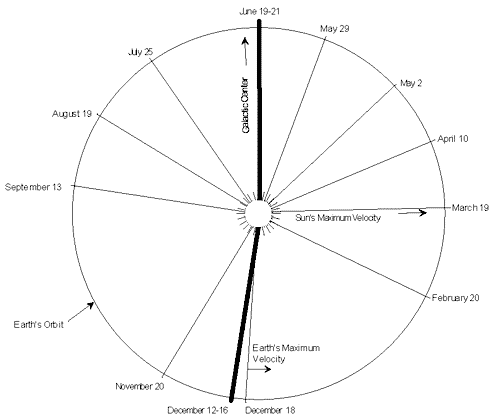
Figure 7.4.1-1.
Energy Conduits Discovered with Gravity Wheel
Experiment
The Orion Connection
The big conduit in the middle of December, shown in Figure 7.4.1-1,
and first week of January leads to another important connection,
that of the great pyramid and the Orion constellation (see figure
7.4.2-1). Research by one of the early Great Pyramid surveyors, Sir
Flinders Petrie, revealed that the King Chamber’s northern air duct
of the Great Pyramid generally pointed to the star Thuban (alpha
Draconis) in the constellation Draco (the dragon), which was the
pole star at the time of the pyramids creation, and the southern air
duct pointed to one of the stars in the constellation Orion’s belt
around 2600 BC.
More precise modern measurements have also shown
that the King’s Chamber’s north and south air ducts and the
Queen’s
Chamber southern air duct date the pyramid at 2450 BC. The details
of this discovery by Bauval is depicted in Figure 7.4.2-2
below.
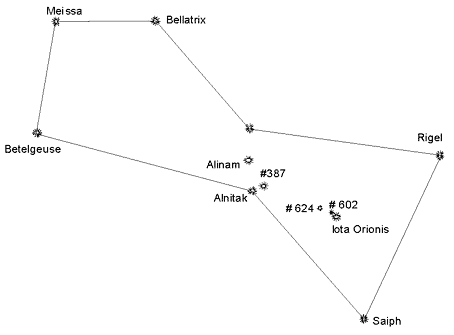
Figure 7.4.2-1.
Orion Constellation.
It is interesting to note that the earth is lined up with the sun
and the three stars in Orion’s belt around the 13th-15th of December
each
year. In the first week of this year, 1997, at sunrise and sunset
the sun is lined up with the 3 stars in Orion’s belt AND with the
axis of the gravity wheel experiment.
In other words, there appears
to be a huge energy conduit (see Figure 7.4.2-3) between our sun and
the constellation Orion which stimulates the gravity wheel force
fields to totally close to all known local forces (i.e., gravity,
electromagnetic, inertial, and radioactivity) and the entire gravity
wheel experiment tried to lift off toward Orion.
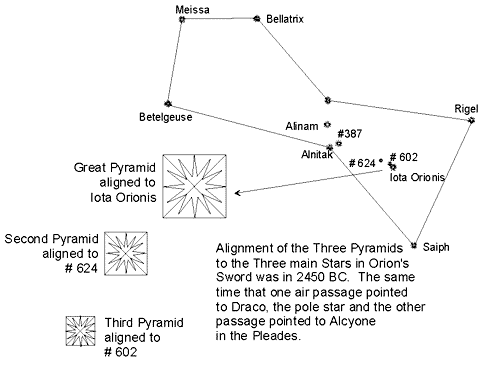
Figure 7.4.2-2.
Correlation of the Orion with Great Pyramid.
Did spacemen from Orion build the Great Pyramid? Is the energy
conduit a communications and stellar
stargate? Remember, the Parr
gravity experiments tries to fly (gravitate?) down the energy
conduit. That is why the experiment loses weight.

Figure 7.4.2-3
Correlation of the Gravity Wheel Experiment with
Constellation Orion.
|













